ASE A4 Steering Suspension Practice Test
11. Technician A says the Z in P225/60R16 89Z indicates the tire's speed rating. Technician B says different sized tires on the rear of a vehicle will illuminate the yellow ABS warning light. Who is correct?
- A. Technician A
- B. Technician B
- C. Both A and B
- D. Neither A or B
12. A vehicle's steering wheel does not return to center after completing a turn. Which of the following is MOST likely causing this condition?
- A. A loose inner tie rod end.
- B. A binding ball joint.
- C. A loose outer tie rod end.
- D. Worn stabilizer bar bushings.

13. Component A in the illustration above:
- A. Is part of the vehicle’s shock absorbing system.
- B. Absorbs impact as a vehicle travels over potholes and bumps in the road.
- C. Can be found on both front and rear suspension systems.
- D. All of the above.
14. A vehicle with power steering requires increased effort to steer. A power steering pressure test gauge is installed to test the power steering system's flow and pressure. To measure power steering pump pressure:
- A. Close the shutoff valve for 5 seconds.
- B. Open the shutoff valve and hold the steering wheel against its stop for 5 seconds.
- C. Close the shutoff valve for 30 seconds.
- D. Open the shutoff valve and record the reading at 1000 RPM and 3000 RPM.
15. After adjustments are made, the technician measures the worm shaft bearing preload and sector shaft lash of a recirculating ball steering gear. The technician should use:
- A. An outside micrometer.
- B. An inch-pound torque wrench.
- C. A dial gauge.
- D. A foot-pound torque wrench.